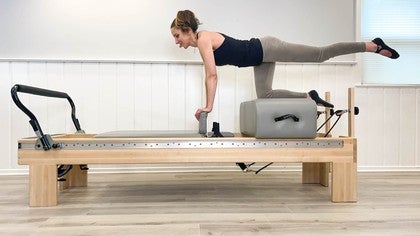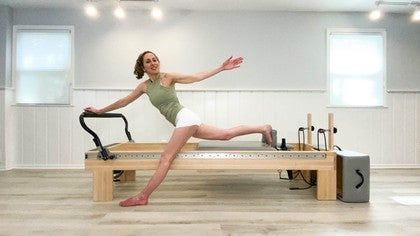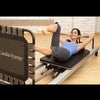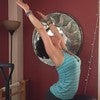Description
About This Video
Transcript
Read Full Transcript
Hi, and welcome to Pilates-ish, The Reformer Series, or as I like to call it, the verb series. So each class, (there's going to be six), are going to be around a theme of an action verb. This class is the first one, and it's going to be "push." So basically, nearly every exercise that we do in this class will involve a pushing move. So wish me luck, and good luck to you as well. I'm starting, actually, on the Reformer with the box to the front.
Now, depending on how tall your Reformer is, you might not need the box. Mine is 18 inches, so it's a little bit high, and then I have my Reformer set to kind of a lower setting. And there's a reason for this. I want to use the foot bar to make me feel more balanced. A lot of you know that I have Multiple sclerosis.
I've had it for like 20 years. I have a lot of issues with my left leg, and one of them is, doing any kind of balance exercise on my left leg, is just a little bit scary for me. So I like to find ways that I can do it where it's a little bit less, like I feel like I'm going to fall. So this also might work for some of your clients who are a little bit more fearful. So I'm going to step up on the box, and I'm going to turn around so that my foot is on the carriage.
And what I want is for the foot bar to be in a position where I can have it kind of behind my knee, and be standing pretty upright without feeling like I'm going to fall over. I'm on one red spring, I'm just going to push back, and in, eight times: 2, 3, 4, 5, 6, 7, and 8. I'll go back like halfway, with little pulses for eight: 2, 3, 4, 5, 6, 7, and 8. I'll go ahead and let it come in, and I'm just going to do a quarter turn, so that I'm standing, sort of, if we were doing like, our skaters series, I'm going to let my, let's see, I'm going to have my left foot be kind of right on the edge. So it's going to be a little bit internally rotated.
I'm going to put a little bend in my right, and then I'm going to try to get my hips to be a little bit more square here. Now, this one isn't as scary to me. So I don't need to have my leg pushing up against the foot bar. However, the foot bar is right there if I feel like I need something to hold onto. So, we're going for about eight: So I think that was about 4, 5, 6, 7, and 8.
Then we're gonna do little pulses: 1, 2, 3, 4, 5, 6, 7, and 8. And then we can go ahead and kind of stand that all the way up. We're going to take another turn. This time, we're going to be facing this way. So this is actually, kind of, one of the scarier kind of lunges to me.
But what I want to do is, I'm just going to go forward until I feel my leg touch the foot bar, so I have some feedback, and then I'm going to try to stand back up, putting my weight in my, (this is my better side) in my right leg. Go out, and in. And again, the foot bar is right there, if you feel like you need to grab a hold of it. 4, 5, 6, 7. Now, on this next one, we'll stay kind of in that leaned out position, we'll bend, push eight times: 2, 3, 4, 5, 6, 7, and 8.
And then I can just bring my hands down to the foot bar, swing my leg around, and then I'm going to repeat, essentially, the entire thing on the other side. So first, turning around, I'm holding onto the foot bar, and I can just swing my leg around to find the carriage. My left leg, again, this is my less-stable leg. My knee is kind of, the back of my knee is up against the foot bar. So I'm going to push back eight times: 1, 2, 3, 4, 5, 6, 7, and 8.
Little pulses for eight: 2, 3, 4, 5, 6, 7, and 8. Quarter turn, so that my left foot is in parallel. My right foot is still in, it's also in parallel. It's just a little dropdown, I'm trying to keep my pelvis relatively square. I'm going to push out eight times: 2, 3, 4, 5, 6, 7, 8.
Then I have little pulses for eight: 2, 3, 4, 5, 6, 7, and 8. Then I would do my last little turn. So I have my foot here. This is my questionable-balance side. So I'm going to do one holding on, because I want to see exactly how far out I'm going to feel like I need to go.
And then I can also hold onto the wall, cause I have a wall close enough to me. Maybe not. So, I'm actually going to just hold on in this one. So I'll go out and in, 2 I think a lot of us are very unwilling to admit that we need modifications. So, embrace modifications. Modifications are designed to make an exercise more accessible to you.
They do not make an exercise wrong. They just make it a little bit different. Now on this one, I'm going to stay out, and I'm going to bend, extend my leg eight times: 2, 3, 4, 5, 6, 7, and 8. And then I'll go ahead, swing my leg around to the side. Then I'm going to lift my foot bar up to, what I'm going to consider, like the normal height of the foot bar.
So just a little preview: we're going to be doing some tendon stretch variations in this class. It's a great push exercise, also great pull exercise. So it's really where you change the emphasis. But I think the stepping up into the tendon stretch is like kind of a scary exercise, so this is how I like to teach it. I like to have the box.
If you have a high Reformer, behind the Reformer, so that you can just work on shifting your weight into your hands, lifting a leg up, and then lowering back down. We'll do eight of these: 2, 3, 4, 5, 6, 7, and 8. It also works if you're going to do the fancy, where your leg is out to the side. So your lift up leg goes out to the side, and now we'll just do four: 2, 3, and 4, and then we'll switch our stepping up leg. So stepping up on the left, lift up, and then you kind of do have this sense of just trying to really have your weight pushing into your arms, because that is what you would be doing, if you were doing for real tendon stretch.
There's four, we'll do four more: 1, 2, 3, and 4. Then we've got the four out to the side: 1, 2, 3, and the last one is 4. Go ahead and come down. We're done with the box, for now, so you can go ahead and put it away, and then we're going to come back to just the carriage. Okay, so go ahead and make your way onto the carriage.
We're going to be doing a variation of stomach massage. These are nice high-waisted pants, so I don't think I'm gonna be flashing any of you. And, I don't think I'm going heavy enough with this, where I'm going to feel like I'm slipping. Also, we're not doing a hands-off version. I have a red blue spring on, you can have anywhere up to three reds.
You can actually do whatever you want, it's your workout, but I want it to be on a red blue. I'm going to kind of scoot myself far to the front, and then I'm starting with my feet on the frame. And then I'm going to come into that little bit of a teaser back, where you kind of tilt your pelvis under a little bit. I'm going to push out, so that my right foot can come to the foot bar, and my left foot is on the frame. Push with my right.
Lower lift with my right, and then bend to come back in. I'll push out, lower lift (my ankle cracked). Push out, lower lift, and in. We're doing eight total: here's, is that three or is that four? I'll say that's three, just in case I'm counting wrong.
4, 5, (it's cracking on, like, every one) 6, 7, Really feel like at this point, I should just light up like a glow stick every time things crack, but you know, we get older, but we don't necessarily have more fun doing it. I'm gonna go ahead and bring my right foot down, my left foot up. Same deal, I'm going out, really pushing with my left, bend to come in. Push out, lower lift, and in. Here's 3, 4, 5, 6, 7, and 8.
I'm going to go ahead and lower that foot down. I'm just going to take off the blue Springs. I have just one spring. So we're going to do a hundred variation, no straps, still about pushing. So I guess I could be pushing into straps, but I don't want to, I want do it different.
So I'm going to be a little bit away from the shoulder rest, just so I don't get caught up on them. Legs in a Pilates V, press my legs all the way straight, head and chest lift. I'm going to pump my arms. I'm going to inhale and exhale. There's 1, 2, 3, 4, 5, 6, 7.
Try to keep your shoulder blades off the mat. 8, 9, and last one is 10. Just go ahead and rock myself up. I just want to add one spring, so we're going to do a pushing legs and strap series. So I'm going to make my way onto my back, headrest down, because my hips are not going to be after a short period of time.
So go ahead and step your feet in. We're going to start with one of the best exercises in all of Pilates: The Frog. So just go ahead and bend your knees in. I am good with you having your knees come in as much in this exercise as you're not, like, letting your hips lift off for this particular version. Go ahead and push your legs out.
I know some people stop, like knees above hips. I never found that very satisfying. I always feel like going in a bigger range of motion is a happier frog. Bend, and push. Bend, and push.
I feel like it used be like a Sesame street thing, where it's like, "the word of the day is push." And so we just look for how many times I say it in this class. Bend, and push, couple more times. Bend, and push, and bend and push. Now we're going to let your legs lift up towards the ceiling. They don't have to go all the way straight up.
We're going to do a bend your knees into a frog without moving the carriage, or at least that's the goal. Bend, push, 1. Bend, push, 2. Bend, push, 3. Bend, 4, 5, 6, 7, and 8.
Our break is to push down some. Now, on this next variation, we're going to do, sort of like Peter Pan. You have a leg go out to the side. This, I learned it as walking on the ceiling. It's the same thing as a Peter Pan, except your legs stay in parallel.
So you're going to bend one knee. So I'm bending my right, lifting my left up towards the ceiling. And then you push through both to join your legs back at that 60 degrees or so. Bend, and push. One knee bends, the other leg lifts.
Both legs try to push evenly. Push down, lift up, push down, lift up, push down, we'll do a couple more. Lift, and push, and lift, and push. And just because it's fun, we're going to go into external rotation. It's the same exercise.
It's that bend reach, 1, except for an external rotation. So your leg goes out to the side. Bend, and reach, bend, and reach. And I sometimes like to bring my hands onto my hips just to make sure I'm not getting all crazy and having my legs slide to one side. Sometimes I think it feels like it'd be really fun to just let your legs, like, go where they want to go.
But we also don't want to fall off the machine, because I think that would be probably not nearly as fun. We're going to call this the last one, and then we'll come back to center. We're going to go ahead and bend back into a frog. This time we're going to take our frog into a high frog. So you're going to let your hips lift up and over, till you find, close to the stopper, or I'm actually all the way in the stopper.
So where your hips are, you're going to try to keep them there, push your legs up and forward and bend. 2, and we'll do eight: 3, 4, 5 6. Did I say eight? I think I meant four. Oh, well, 7 and 8. Now you're going to fold straight legs back, push forward.
And we'll just do four of these, cause these are harder. 2, 3, and keep pushing, keep pushing, keep pushing, keep pushing, find a lot of length. Lay your spine down slowly. It's sort of like, a long spine, and then you can just let your legs kind of lift for a stretch. I'm just grabbing hold of the straps, so that I can give myself more of a controlled stretch where I want it, and then you can go ahead and bend your knees.
Take your legs out, just do one little set of supine triceps, so you're just going to do a push down, and bend, press and bend. If you want to make it harder, you can have your head lifted. If you want to make it harder, you can extend your legs out and low, bend, and push, a couple more. And last one, and then I'll go ahead, let my arms lift, let my feet lower. Hang the straps up, and let's go ahead and rock up to seated.
So we're gonna do kind of an Elephant Plank series. You can be on - The heavier it is, the more upper body it is. The lighter it is, the more abs it is. I'm going for a split the difference, so I'm going for, like, red, blue, red, yellow. So go ahead, and make your way up onto the carriage.
And if you are very tall, you can have your feet go all the way to the back. If you are feeling less tall today, you can bring your feet in a little bit. So first, we're just going to do, kind of, our regular flat, or, back. I know my back is not completely flat, but flat-ish back Elephant, so you're just going to push back a little bit, and pull to come in. Don't get confused, this is not the pull class.
The pull class will be much harder pulls than anything in this class, push out, pull in. Push out, pull in, push out, pull in. Now we're going to do basically exactly the same thing, except our push is also going to involve plantar flexion. So push, lift up to your tip toes, and back in. Push, lift up to your tip toes, and back in.
I try to involve a lot of plantar flexion into my regular workouts, because that is an area of weakness for me. So, only on one leg, I have one huge calf and one that's like half the size. So I try to do stuff to sort of, at least get those muscles working a little bit. We'll do a couple more. And, last one.
I'm gonna walk, feet back, so that you are on tiptoes. We're going to push back, so you're basically in a plank. We're going to carry that forward, push it back, you can really, really, really go for the push, and then carry it forward. Push back, and carry it forward. Push back, and forward, push back.
I'm gonna see if I can go all the way to the stopper. Like where is the stopper? Somewhere, I didn't quite get there. And, in, last one. Last one, best one.
Push back, and pull to come in. I'm going to come into a slightly shorter version of a Elephant. So my foot is more forward, I'm going to push back. But what I want to do, is just concentrate on ankle range of motion in my left ankle. So I'm dorsiflexing, plantar flexing, and my dorsiflexion on the left basically is nonexistent, so if you're like, "you're not really dorsiflexing," it's like, well that's the best I can give you.
Bend, and push, and bend, and push. I'll go ahead, lower my left foot, lift my right foot and push back a little bit. And then same thing. Think about moving from your right ankle this time. Bend, and push.
Bend, and push, and bend, and push. we'll do like three more: 1, 2, and 3. I'm going to come in closer. I'm going to change it so it's on one blue, 'cause I'm going to stand pretty close to the front. And then we're going to do a, sort of, push out and then into a push up at the same time.
So just stand reasonably close to the front. I'll push out, bend, lift up. And we'll do five: 2, 3, 4, and last one is 5. Next, we'll do like a quick, as in 5, 5, 5 version of knee stretches, anything that is called a stretch in Pilates, don't trust it. It's probably a lie.
Knee stretches, one of the best examples of the Pilates lies, I'm going to do a series on that one day. So, you're going to sit your heels back towards your hips, tuck your pelvis under. So I always think you're at the starting gate, like you're a hurdler or something, tuck your pelvis under. This situation, this is not going to change. The lower part is going to change.
So you push back, pull in 1, 2, 3, 4, and 5. You come in, extend your chest, sort of an arch back, five here: 1, 2, 3, 4, and 5. Back in, back to your round position. I have a little problem with my left foot not wanting to have my toes tuck under. So I'll lift my knees up and it's out, in, five: 2, 3, 4, and 5.
Let your knees lower down. Go ahead, and you can come in from there. Sort of shake it off. We're going to grab the box, and we're going to put it on short ways. We're going to come to one red spring.
So, for this, I think I am going to put the box over, well, we'll see, I might put it over the back, to give myself a little bit more room, but then the next exercise, I think I want it over the front. So I think I'll put it in the front, meaning in front of the shoulder rests. So we're going to do a little bit of a tricep press, leg press. So, let's do that second, because that one's harder. So first, I'm going to go ahead and make sure the box is on, in the center.
And then we have a seat on the box. I'm going to reach back for the straps, and I have the double straps, so I have the the two loops. So I have the big loop and the small loop. I think I'm gonna use the big loop. I'm just thinking about this as a chest press, I'm going to push forward eight times: 1, 2, 3, 4, 5.
Do a couple more, couple more, and last one. And then we'll go ahead and hang those straps up. Okay, so think about if you were doing the tricep dips that you do on the chair, how your butt kind of goes off the edge. That's my goal for where I'm going to be hovering. Feet are going to come to the foot bar, and they could be parallel, you could be on your toes, you could be on your heels, You can be wherever you want to be on your feet.
Make sure your hands feel like they're relatively secure. Take your shoulders, roll them down your back some. You're going to bend your elbows, and push. Push your legs out, and in. Bend, and push, legs, go out, and in.
Bend, and push, legs reach, and these are really hard. Bend, and push, legs out, and in. Tiny bends for four: 2, 3, and 4, you can sit yourself all the way back up. Okay, so let's go ahead and make your way onto your right knee, and bring your left knee onto the box. And I'm going to kind of, scooch my right leg, the official term: scooch, my right leg a little bit closer to the box.
And then my right hand is down on the foot bar. I'm just going to find length as I push out, and then come back in. Push out 2, push out 3, we'll do six: 4, 5, and 6. So now we're going to find a split-the-difference halfway pushed out. So push out a little bit.
I'm going to take my, maybe I won't push out. I'm not going to push out at all, I changed my mind. I'm going to make sure I am stable through my shoulder. That is the most important thing here, if you want to push out and do that, you do that. Lift your top leg up, we'll push it back eight times: 2, 3, 4, 5, 6, 7, and 8.
And then, we'll go ahead, untangle ourselves, and make our way onto our opposite leg. So my left knee is going to be scooched in, my right knee is going to be on top. I'm going to work on six presses out: push out 1, 2, 3, 4, 5, and 6. I'm going to come into the stopper, lift my top leg, push it back. eight times: 2, 3, 4, 5, 6, 7, and 8. And my push was actually a slide, because my outer hip was telling me, no, it did not want to do that.
I'm going to add some springs, and I'm going to change my box to long box. I'm just adding the Springs, because I actually don't want to move the carriage. So I just put on all the red springs, and then I take the box and turn it so that it's facing front and, ideally right in the middle, I'm going to come to kneeling on the box. And I want to basically be in a quadruped position with my hands on the foot bar and my knees on the box. I'm going to start with just a little lean forward, basically like coming into a kneeling plank, and then a push back.
Come forward, and push back. And we'll just do three more of these: 1 (there's a lot of creaking happening), 2, and 3. Then we'll come to a regular quadruped position. We're going to take your right leg and lift it up. From there, you're going to let your right leg lower down to the right, while your hips go back a little bit.
And then you come forward to your quadruped with your leg lifted, then you're going to go across, as you lean back some, and then you push back to that quadruped with one leg up. So you're going down and out, down and cross. Down and out, down and cross. We'll do two more: down and out, down and cross. And last one, down and out, and down and cross.
Knee comes down, we'll go to the other leg. So your leg is up, we're going to go out to the side first, as you lean back some, and up. Down and cross, and upward, and five total: here's 2 and 2, 3 and 3, 4 and 4, and last round, and five. I'm gonna go ahead and have a seat, and I'm just going to straddle the box. So, I want my knees to actually be by the side of the box, and my toes are kind of tucked under.
So it's sort of like Horseback, except that's a pulling exercise, and this is going to be a pushing exercise of Horseback. So you're going to bring your fists, or if you have really long arms, the flats have your hands down. So your fists are going to come down, you're going to think about pulling your abs up, as you push down into your arms, think less pushing with your legs. This is really more of a pushing with your arms, lifting up with your abs. You lift up, and down.
We'll just do three like that: 2 and 3, and this next one we'll hold for four: 2, 3, and 4, and then go ahead and lower down. So I've tried this, it's never worked out. So maybe magic will happen today. We're going to go, legs kind of reaching down, not so much down and forward, they will go straight, but probably not too much forward. You're going to push down, and work on trying to get a little bit more airborne, but you still can have the squeeze on your legs, like if you were doing like regular Horseback, and then you'll lower it all the way down.
I'm just leaning forward to take off two springs, so I'm down to one red spring. If you have questionable knees, this might not be the exercise for you. In which case, you can always leave it out. I'm just going to basically treat this as if it's the quad extension machine at the gym. So I'm hooking one of my ankles, and then I'm going to hook my other ankle.
And then I'm just going to let my knees bend backwards, and then I'm going to push my legs straight. And it does slide up a little bit, but it doesn't slide up that much. 3, 4, 5, 6, I think I'm going to do 16: 7 and 8, second set: 8, 2, 3, 4, 5, 6, 7, and 8. And then I'm just going to actually pull on it a little bit, to take it off of my leg, so it doesn't pull my knee in any kind of wacky direction that would be unpleasant. And then I'll go ahead and take that off.
So from here, we're going to move the box onto the floor, and we're going to do some, kind of push-up variations from there. Okay, so what we're going to do now are some pushups. We're gonna have the box next to the Reformer. My box is on its side, which is not the best place for it to be. It's a little wobbly, because it's not high enough for it to be on, like its regular setting.
So, if you have like a 14 inch Reformer, you should be fine on a regular setting. If you have one of the Reformers that's on the floor, you should be good with your Reformer, not using a box. Basically, just trying to get my arms as close to the same height as possible. So I'm gonna step it back into a plank. First thing I'm gonna do, is I'm going to bend my left arm like I'm trying to drop down to my left forearm, and then push.
So I have a little bend in my right arm, not a huge bend, a little bend, and I'll just do five: 4 and five. And then I'll step in just for a second so I can grab hold of the shoulder rest here. This time, I want to bend my right arm and push forward with my left, also for five: 2, 3, 4, and last one is 5. And then the bad news is, that was only half of the sides that we need to do. So we're gonna take the box over to the other side of the Reformer, and then same deal.
You want it to be basically, I set it a little bit forward, that's simply so that I don't run into the foot bar, but it's basically adjacent. And then, this time it's more your left elbow doing more of the bending, or your left arm doing more of the work. So, my arms start together. I'm going to drop to my right forearm, or close and lift up five times: 2, 3, 4, and 5. Little step in, just so I can adjust myself and get my weight onto my right hand on the shoulder rest.
And my right arm goes forward, as my left arm bends five times: 2, 3, 4, and 5. And then I'll go ahead, come all the way in. We're done with the box. So we can go ahead and take the box and put it away, It's a little tight to get through there. And then I'm going to go ahead and just put that down on the floor.
So we're going to finish off one last pushing exercise. We're going to do a tendon stretch variation. I like the foot bar where it is, but I don't like the weight on one blue for a tendon stretch. So I'm going to go for red blue. Two reds is kind of a standard.
I occasionally do it on one red, that would be for the pulling class, not for the pushing class. So for the pushing class, I'm going to be one red, one blue. So you can go ahead and, we're going to come on to the foot bar, and have a seat. Now, be really careful if you have one of those foot bars that can actually pull loose, you don't want it to do that. It's called tendon stretch because you are stretching your Achilles tendon, which means we're going to be on the balls of our feet, with our heels dropping when we come up to a standing position.
So from here, you're just going to stand up, So your legs are straight, your head is dropped, and then sit back down. I just like to always start off with a couple of those, just to see how my hamstrings feel today. Figure out where I am in space. So we'll go up again, we're up, and then back down. Now on this next one, we'll go out, lifting up.
Now, imagine there's a wall behind you, and you can't go through the wall, so you have to push forward, and then lift up. Push forward, and lift up. We're going to go ahead and have a seat, we're going to do two more each side, but on one leg, sort of. So one leg tendon stretch is hard. This is slightly less hard.
So, I'm going to start on my right leg. My right leg is my stronger leg. So my right leg will be my standing leg. So my left foot is just going to cross in front of my right foot. I'm going to stand up, so I'm on my right leg.
I'm going to push out, maybe not as far, pull in 1, push out, pull in, 2. Have a seat, left foot is on, right foot kind of crosses over, and stand up with your weight on your left foot. So we push out, pull in 1. Push out, pull in 2. So, not my most beautiful exercise, but not everything can be all the time.
I'm going to go ahead and just make my way carefully down. And I'm just going to take a turn, and we're going to do a little bit of a lunge stretch. Let's do it on the carriage. So, I have one red spring, that's my happy lunging weight. I have my left foot up against the shoulder rest.
My right knee is up against the foot bar, and first I'm thinking about not pushing down, but actually lifting up, and then tucking my pelvis under, so I feel a little stretched through my quad. Then you can go more down, but think about driving your knee down, and a little bit back, but not so much sinking into your back to get there. Now, if that feels good, and you want to take it into more of a stretch, you can begin to extend your right leg straight a couple of times, or straighter. Like, I don't know that my left leg will go all the way straight. It might just go straighter, and then you can just kind of lift up, kind of lifting in.
I almost said pull, but that's the wrong class. And then just kind of find your stretch there, and let the carriage come all the way in. Switch legs, so right foot's down, knee is down, left leg is against the shoulder rest. Again, I'm thinking more of a tucked pelvis and a lift up, and then you can kind of work on more, where you're getting the quad stretch, kind of pulling in and back, and then we can go to the straight or straighter. Straighter on the side, Push out, and in, and push out.
And, in. And then, you can just go ahead, make your way down to a seated position. If there's any last stretches that you want to take, I'm always of the belief of, "go ahead and take those," listen to what your body wants to do, and modify as needed.
Pilates-Ish with Mariska: On the Reformer
Comments
You need to be a subscriber to post a comment.
Please Log In or Create an Account to start your free trial.




























